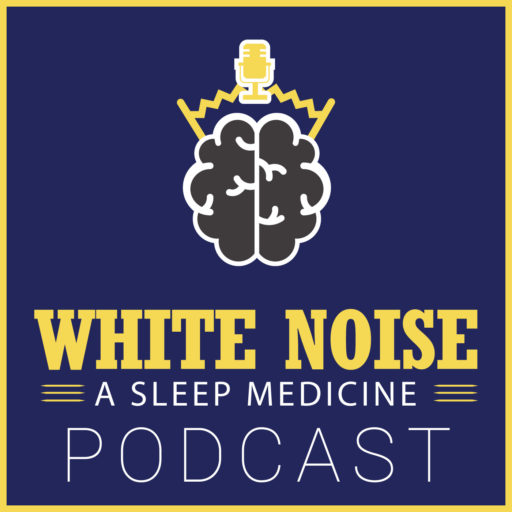
Join The White Noise Podcast in a discussion of the diagnosis and management of Delayed Sleep Wake Phase Disorder (DSWPD) with special guest Dr. Cathy Goldstein, an expert in circadian rhythm disorders in Ann Arbor, Michigan and Chair of the Artificial Intelligence in Sleep Medicine subcommittee of the American Academy of Sleep Medicine (AASM).
CLICK HERE TO CLAIM CME CREDIT
Show Notes – Season 1, Episode 1 – Delayed Phase Sleep Wake Disorder
Definitions:
1. Dim light melatonin onset (DLMO):
- A measure of circadian phase, the dim light melatonin onset (DLMO) is the time at which the secretion of melatonin begins under dim light conditions. The DLMO usually occurs 2-3 hours before one’s habitual nocturnal sleep-onset time.
2. Phase response curve
- In circadian rhythm research, the PRC is a curve representing the relationship between a stimulus (such as bright light exposure or melatonin) and the resulting change in circadian phase (see example below).
3. Phase angle
- A phase angle represents the difference in time between an entraining agent (such as the light-dark cycle) and an entrained circadian rhythm.
4. Tau
- The duration of an organism’s endogenous free-running circadian period in the absence of reference to environmental cues capable of circadian entrainment (zeitgebers). In humans, the normal circadian tau is thought to be approximately 24.2 hours.
Clinical Pearls
Diagnosis of delayed phase sleep wake disorder starts with a good history. Make sure to ask about sleep wake times both during the week and during the weekends. Also make sure to elicit the patients preferred chronotype.
Sleep logs and actigraphy are useful tools in making a correct diagnosis.
There is a natural delay in the circadian cycle which occurs in adolescence.
Being able to estimate DLMO and core body temperature minimum is key to effective treatment.
Low dose melatonin (1-3mg) is preferred, and higher doses may decrease the efficacy of treatment.
Melatonin given around the time of DLMO will cause a phase advance.
Light given after core body temperature minimum will cause a phase advance.
Light exposure after DLMO will cause a phase delay.
Delayed Phase Sleep Wake Disorder-Diagnosis
The diagnosis of DSWPD is centered around a thorough clinical history. We can start by eliciting the patients preferred chronotype (“morning lark” vs “night owl”) simply by asking the patient, or by using a tool such as the morningness-eveningness questionnaire. It is also important to establish the patient’s sleep and wake times both during the work/school week and on the weekend. Are they able to fall asleep easier if they stay up later? Will they sleep in if they do not set an alarm? If DSWPD is suspected, then sleep logs and actigraphy (two weeks of either) will be useful in making a diagnosis, and also helpful in establishing the patient’s DLMO and core body temperature minimum.
Delayed Phase Sleep Wake Disorder – Treatments
Treatment focuses on shifting the patients circadian rhythm to a “normal” sleep time. This can be accomplished by using a combination of melatonin, light exposure, and light avoidance.
Once a general DLMO and core body temperature minimum have been established, the clinician should work with the patient to develop a treatment plan which will enable the patient to sleep at their desired time.
Light exposure should be avoided 4 hours prior to habitual bedtime, blue blocking lenses can be used to accomplish this task. Melatonin (1-3 mg) can be given 2 hours before habitual sleep time (the approximate DLMO), and this will serve to advance the patients circadian rhythm. Upon awakening (ideally immediately) the patient is to expose themselves to bright light. This can be accomplished by using a light box (10,000 lux for 1 hour), or simply by going outside and basking in the sun (100,000 lux or more).
Once these methods have been implemented, the clinician can work with the patient to advance their habitual bedtime. This can be done by going to bed 1 hour earlier each week until the desired bed time is achieved. Once this is accomplished, melatonin can be discontinued, but light avoidance in the evening and morning bright light exposure should be continued.
From Berry RB: Fundamentals of sleep medicine, Philadelphia, 2012, Saunders, p 522
From Eastman CI, Burgess HJ: How to travel the world without jet lag. Sleep Med Clin 2009;4:241–255.
Goals and Learning Objectives
Goal
Listeners will be able to recognize delayed sleep wake phase disorder in the clinic and be familiar with treatment strategies.
Learning Objectives
After listening to this episode, listeners will be able to…
1. Recognize patients with delayed sleep wake phase disorder based on history.
2. Compare and contrast the tools used for diagnosing delayed sleep wake phase disorder.
3. Describe the various treatments for DSWPD.
4. Implement a treatment plan based on a patient’s specific needs.
5. Describe the effects that melatonin and light have on the phase response curve.
Links from the Show
Dr. Goldstein’s recommended reading list
Sack RL. Jet lag. New England Journal of Medicine. 2010 Feb 4;362(5):440-7.
Disclosures
The authors of The White Noise Podcast do not have any relevant financial disclosures.

Great episode! Just started listening and appreciate the content as a current sleep medicine fellow. Thank you Dr. Goldstein for sharing your recommendations in a clear and applicable way!